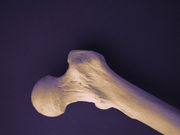Reduced vertebral fracture risk at 12 months among postmenopausal women with osteoporosis
MONDAY, Sept. 19, 2016 (HealthDay News) — For postmenopausal women with osteoporosis, romosozumab is associated with reduced risk of vertebral fracture at 12 months, according to a study published online Sept. 18 in the New England Journal of Medicine. The research was published to coincide with the annual meeting of the American Society for Bone and Mineral Research, held from Sept. 16 to 19 in Atlanta.
Felicia Cosman, M.D., from the Regional Bone Center at Helen Hayes Hospital in West Haverstraw, N.Y., and colleagues randomized 7,180 postmenopausal women with a T score of −2.5 to −3.5 at the total hip or femoral neck to subcutaneous injections of romosozumab or placebo monthly for 12 months. Thereafter, patients in each group received denosumab for 12 months administered subcutaneously every six months.
The researchers found that 0.5 percent of patients in the romosozumab group and 1.8 percent in the placebo group had new vertebral fractures at 12 months (P < 0.001). Clinical fractures occurred in 1.6 and 2.5 percent of patients in the romosozumab and placebo groups, respectively (P = 0.008). No significant between-group difference was seen in the risk of non-vertebral fractures (P = 0.10). After each group made the transition to denosumab, at 24 months, the rates of vertebral fractures were significantly lower in the romosozumab group (P < 0.001).
“In postmenopausal women with osteoporosis, romosozumab was associated with a lower risk of vertebral fracture than placebo at 12 months and, after the transition to denosumab, at 24 months,” the authors write.
The study was funded by Amgen and UCB Pharma, the manufacturers of romosozumab.
Copyright © 2016 HealthDay. All rights reserved.








